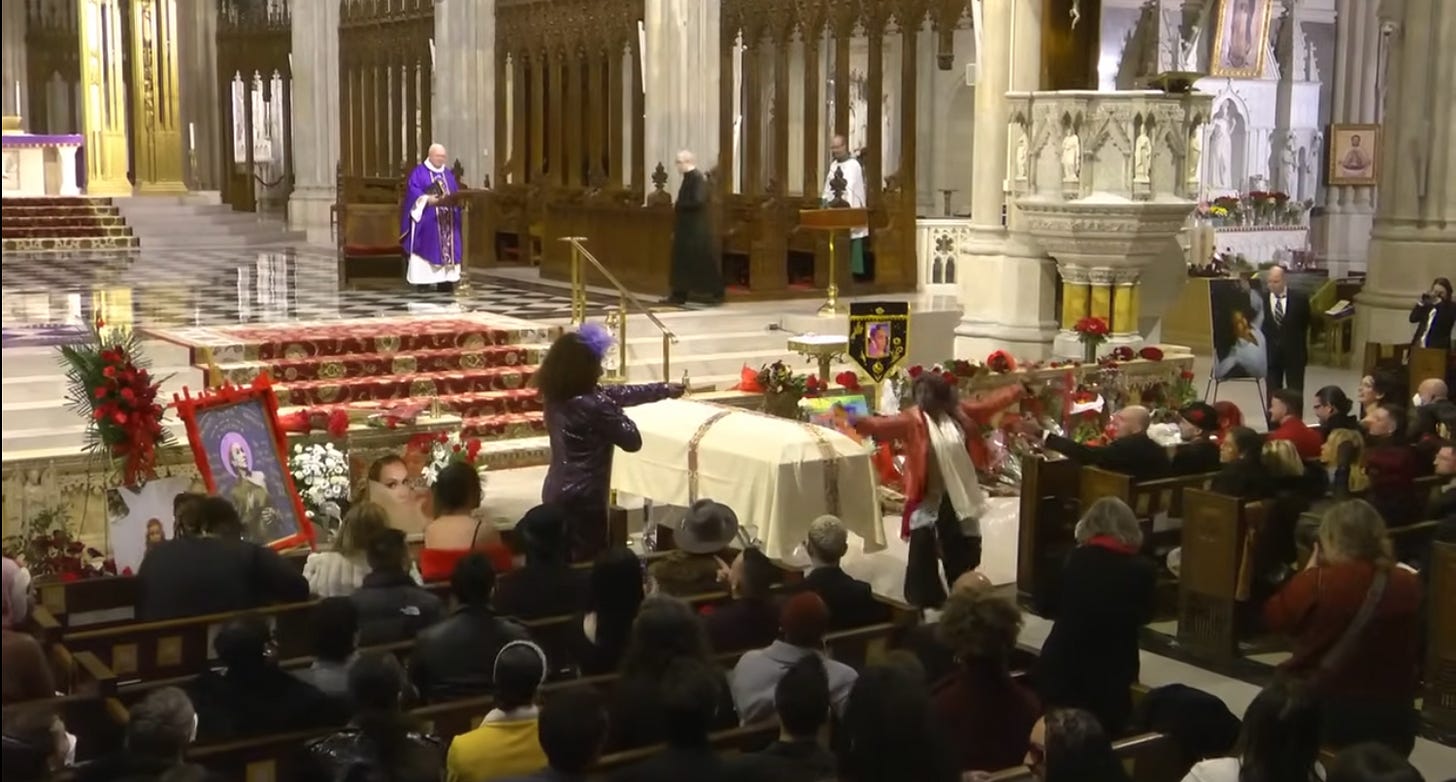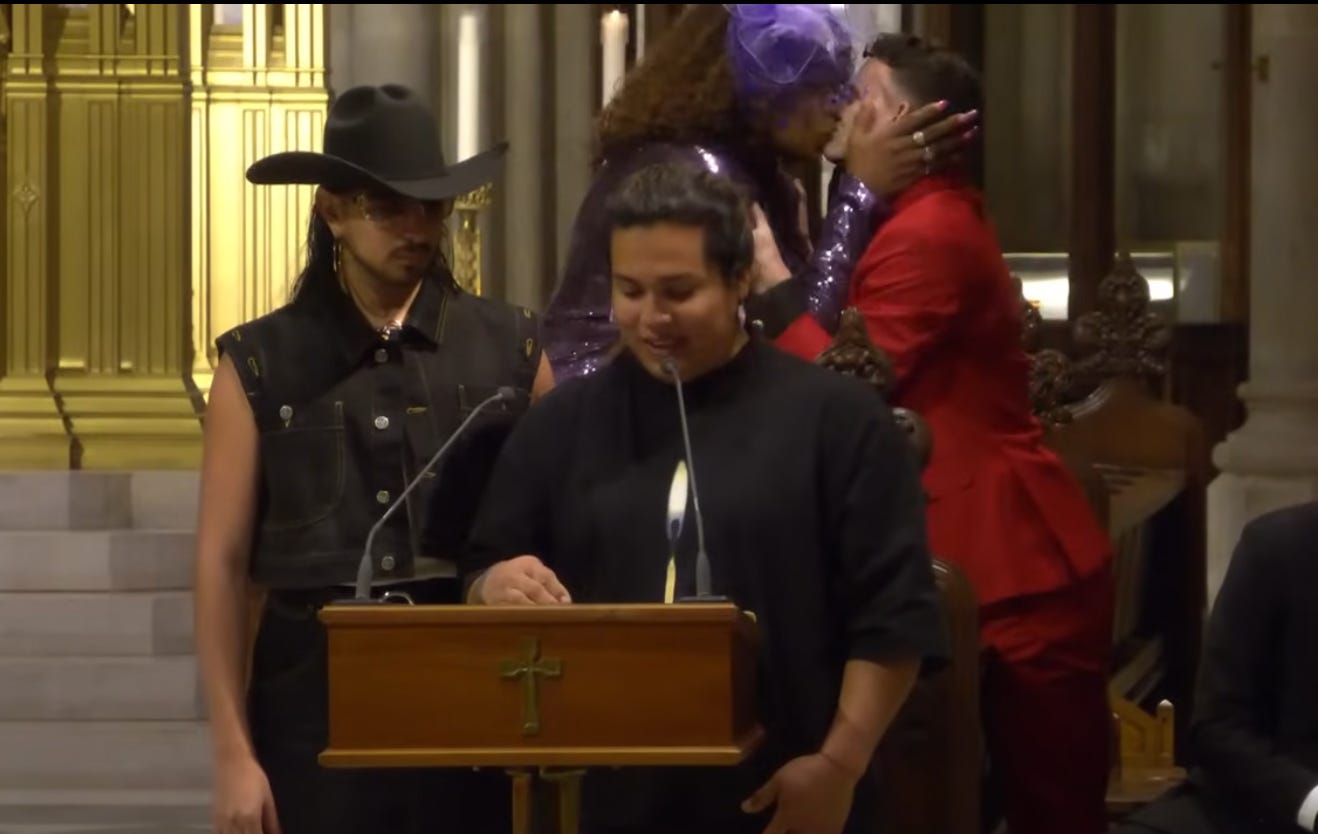About that funeral … What happened at a controversial NYC liturgy last week?
The funeral of LGBT activist Cecilia Gentili at St. Patrick's Cathedral has raised controversy. Here's what you need to know
Pillar subscribers can listen to this story here: The Pillar TL;DR - About that funeral … What happened at a controversial NYC liturgy last week?
The Archdiocese of New York made headlines Friday, after a funeral was held at St. Patrick’s Cathedral for transgender activist Cecilia Gentili, who identified as a transgender woman and an activist.
The funeral, first reported on by the New York Times, packed the cathedral with more than 1,000 mourners, many of them LGBT activists or presenting themselves as transgender.

The funeral service, which was not a Mass, drew criticism after a eulogy described the deceased as a “great whore, St. Cecilia, the mother of all whores,” and after a rendition of “Ave Maria” sung during the liturgy was interrupted by a mourner who shouted “Ave Cecilia,” and danced down the aisle.
The priest celebrant, Fr. Edward Dougherty, was also criticized for using female pronouns to describe Gentili, a biological man who identified as a woman.
And, along with issues in the liturgy itself, some critics also charged that it was inappropriate to permit a funeral for a transgender activist, paving the way for a rite charged with symbolism, in what the NY Times called “an exuberant piece of political theater.”
So what exactly happened? What happens next? And what does the Church say about ecclesiastical funerals, anyway?
How did this funeral come about?
Gentilli, who died Feb. 6 at 52 from undisclosed causes, was a well-known activist for trangender causes.
Born in Argentina, Gentili was reportedly a victim of child-sexual abuse in the 1970s, and came to the U.S. in 2002 as an undocumented immigrant. There, Gentili struggled with homelessness, heroin addiction, and engaged in sex work in order to earn a living.
After being granted political asylum in the United States and overcoming heroin addiction, Gentili founded a consulting firm which advised companies on LGBT employment issues.
Gentili was an outspoken advocate for the decriminalization of prostitution, a fundraiser for transgender causes, and advocated for New York’s 2019 Gender Expression and Discrimination Act, which added gender identity to protected employment classes in state law.
Ceyenne Doroshow, a friend who organized the funeral told the NY Times that Gentili — reportedly a self-professed atheist — had wanted to have a funeral at St. Patrick’s Cathedral because the church is “an icon.”
Doroshow did not tell employees at St. Patrick’s that Gentili was a biological male who identified as transgender, or that the funeral liturgy would include elements of political activism, or that the deceased would be celebrated as the “mother of all whores” during the liturgy.
The funeral was originally scheduled to take place during a Mass, but became a funeral liturgy outside of Mass as it began Thursday, with the priest celebrant heard on a livestream discussing quietly with cathedral musicians that they would change plans so that the liturgy would not include a Eucharistic liturgy.
Can people who identify as transgender have a Catholic funeral?
The Church does not have specific norms about funerals for people who identify as transgender.
The Code of Canon Law explains that there are people who “must be deprived of ecclesiastical funerals” — among them, “notorious apostates, heretics, and schismatics,” and “other manifest sinners who cannot be granted ecclesiastical funerals without public scandal of the faithful.”
In the Church’s practice, the fact that a deceased person experienced gender dysphoria or identified as a transgendered person does not usually by itself constitute a de facto prohibition on funerals— but a person who is an activist for causes contrary to Church doctrine would more likely be judged by a pastor or diocesan bishop to fit the “manifest sinners” or “public scandal” clauses of the law.
The Church recognizes that gender dysphoria is a psychological condition, which can manifest in a person’s identification as a gender inconsistent with their biological sex. And while Pope Francis has been a sharp critic of “gender ideology” in contemporary culture, the Holy See has also said in recent years that a person who identifies as transgender can participate in the life of the Church, as long as the possibility of scandal is considered.
In November 2023, the Vatican’s Dicastery for the Doctrine of the Faith said that a transgender person who has undergone surgery can receive the sacrament of baptism “under the same conditions as other believers, if there are no situations in which there is a risk of generating public scandal, or disorientation among the faithful.”
The DDF also said that transgender adults who had undergone surgery could serve as godfathers or godmothers “under certain conditions.”
“However, since this task does not constitute a right, pastoral prudence demands that it not be permitted if there is a risk of scandal, undue legitimation or disorientation in the educational sphere of the ecclesial community,” it said.
The Vatican’s doctrine office said there is no prohibition in canon law on a transgender person acting as a witness at a Catholic wedding.
While some dioceses have issued guidelines regarding funerals for Catholics in same-sex unions, few have done the same regarding persons who identify as transgender. The published liturgical guidelines for funerals in the Archdiocese of New York do not address questions regarding the prospect of denying funerals in particular cases.
So why was Gentili’s funeral criticized?

While the criticisms of Gentili’s funeral liturgy were varied, the majority of them seemed to focus on the propriety of the liturgy itself:
That the priest celebrant consistently used feminine pronouns for Gentili, describing the deceased as “our sister,” and using a name apart from Gentili’s baptismal name,
That the steps to the sanctuary were decorated by attendees with LGBT-themed flags and similar items,
That participants celebrated Cecilia as a “whore,” a “puta,” and as the “mother of whores,” in a manner that seemed to glamorize prostitution,
That the intercessory prayers included a call for “gender-affirming” healthcare,
That prayers to the Blessed Virgin Mary were interrupted, with a participant shouting “Ave Cecilia” over the “Ave Maria,” and dancing around the deceased’s casket,
That “words of remembrance” were offered by the deceased’s male partner, which focused on their union, and by a transgender person who referred to “girls like me” from the cathedral’s pulpit,
That some “words of remembrance” focused on political advocacy regarding transgender issues,
That a transgender person could be seen kissing another man in the Church’s sanctuary while “words of remembrance” were offered,
That the liturgy included raucous chanting and interruptions at various times,
The the deceased was frequently celebrated as a “saint” during the liturgy.

What has the Church said?
Initially, the Archdiocese of New York said little about the controversy..
On Friday evening, archdiocesan spokesman Joseph Zwilling told The Pillar that “When the cathedral gets a request for a funeral from a Catholic, they do their best to accommodate that request, as any parish would and should. The cathedral is a parish; it is not a museum or a tourist attraction. They celebrate Mass, weddings, baptism, confirmation, and funerals.”
“The Church has a sacred obligation to bury the dead. It is a corporal work of mercy,” he said.
“There is one thing of which I am certain about every funeral that has taken place in Saint Patrick's Cathedral since it's opening some 150 years or so ago: Every single one has been for a sinner in need of God's mercy,” Zwilling said, seeming to defend the choice to hold the liturgy.
But on Saturday, Fr. Enrique Salvo, St. Patrick’s rector, issued a different statement, expressing “outrage” over the liturgy.
“Thanks to so many who have let us know they share our outrage over the scandalous behavior at a funeral here at St. Patrick’s Cathedral earlier this week. The cathedral only knew that family and friends were requesting a funeral Mass for a Catholic and had no idea our welcome and prayer would be degraded in such a sacrilegious and deceptive way. That such a scandal occurred at ‘America’s Parish Church’ makes it worse; that it took place as Lent was beginning, the annual forty-day struggle with the forces of sin and darkness, is a potent reminder of how much we need the prayer, reparation, repentance, grace, and mercy to which this holy season invites us,” the priest wrote.
“At the cardinal’s directive, we have offered an appropriate Mass of Reparation,” Salvo added.
The Mass of Reparation is not the only one known publicly to have taken place in New York City recently. In November, Bishop Robert Brennan offered one in at Brooklyn’s Annunciation of the Blessed Virgin Mary Church, after a music video described as “lewd” and “sacrilegious” was filmed there.
Last week’s liturgy received numerous comments from Fr. James Martin, SJ, a priest who is outspoken on LGBT issues. Initially, Martin told the NY Times that the liturgy was “wonderful” and “a powerful reminder, during Lent, that L.G.B.T.Q. people are as much a part of the Church as anyone else.”
But after controversy emerged, Martin offered a different perspective. On Friday, Martin tweeted that while he had not watched the whole funeral, “some actions I've seen struck me as, while perhaps to the congregation joyful and celebratory, disrespectful of the sacred space that is St. Patrick's Cathedral.”
The priest added that he had been invited to preach the funeral, but he could not because he was out of town — Martin gave a speech Friday at the Religious Education Congress of the Archdiocese of Los Angeles.
He also clarified that while he praised the funeral to a NY Times reporter, he had done so before the liturgy had actually taken place.
Martin himself was recently featured in the NY Times, as he offered and administered a blessing to a same-sex couple, with a reporter and photographer present, in a move widely criticized as a violation of the Vatican’s Fiducia supplicans.
What will happen next?
Comments heard on the funeral’s livestream make clear that the priest celebrant was caught unaware of who Gentili was, and how the funeral liturgy might unfold. The priest seemed frequently uncertain of how to proceed amid the controversial elements unfolding at the funeral.
Some Catholics have asked whether the Archdiocese of New York, or the cathedral in particular, might develop a more robust screening process before scheduling funerals, to ensure that the deceased was a practicing Catholic, and that a funeral liturgy will be offered appropriately.
Canon law establishes that when there is doubt about whether to approve or deny a funeral in a potentially scandalous case, “the local ordinary is to be consulted, and his judgment must be followed.”
In New York City, local ordinary Cardinal Timothy Dolan has not yet said anything about the liturgy, or the scandal surrounding it, though the cardinal offered Mass at St. Patrick’s cathedral on Sunday, and has released videos on social media concerning other topics.
Dolan has in the past discussed controversial topics on his Wednesday radio show, and could face pressure to discuss the funeral during his radio show this week.
The Mass of Reparation at St. Patrick’s Cathedral was not livestreamed, and details have not been released publicly.

Father Martin also said that he made his comment a to the NYTimes under the assumption that Gentili was a believer. That a professed atheist should have their funeral at St Patrick's Cathedral, then continue to mock the Catholic faith throughout the ceremony, is what bothers me most about this story.
That poor priest. I guarantee you he was simply assigned to it and given nothing more than a fact card from the funeral home. The question of “how to handle this on the spot without creating a riot” must have been on his mind.